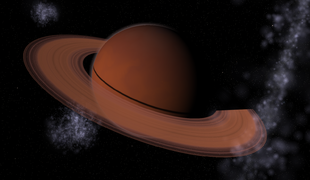Gliese 876 c
|
Exoplanet Gliese 876 c |
|
|---|---|
| Artist's impression of Gliese 876 c with a hypothetical ring system | |
| Constellation | Aquarius |
| Position equinox : J2000.0 |
|
| Right ascension | 22h 53m 16.73352s |
| declination | −14 ° 15 ′ 49.3186 ″ |
| Orbit data | |
| Central star | Peter 876 |
| Major semi-axis | 0.134 ± 0.001 AU |
| eccentricity | 0.250 + 0.001−0.002 |
| Period of circulation | 30.126 +0.011−0.003 d |
| Further data | |
| Minimum dimensions | 241.5 +0.7−0.6 M ♁ |
| distance | 4.660 ± 0.004 pc |
| history | |
| discovery | Marcy et al. |
| Date of discovery | 2001 |
| Catalog names | |
| GJ 876 c, IL Aqr c, HIP 113020 c | |
C gliese 876 is a Exoplanet which the 15 light-years from the sun away red dwarf Gliese 876 in the constellation Aquarius orbits. It is the second innermost known planet in the star's planetary system .
discovery
After Gliese 876 b had already been discovered in 1998 , measurements of the star's radial velocity by the Lick Observatory and the Keck Observatory over six years led to the detection of a second planet by a team of astronomers led by Geoffrey Marcy in 2001 . He had already played a key role in the discovery of Gliese 876 b.
properties
Gliese 876 c orbits its central star at a distance of about 0.134 AU in just over 30 days. Its minimum mass is a little more than two masses of Jupiter . It is in a Laplace resonance with its outer neighboring planets Gliese 876 b and Gliese 876 e : two of Gliese 876 b and one of Gliese 876 e account for four orbits of Gliese 876 c. The three planets are comparable to the three Jupiter moons Io , Europa and Ganymede , which are also in a Laplace resonance.
It is believed that the three outer planets of Gliese 876 were formed at a greater distance from the star and then migrated into their current orbits. The orbit inclination of Gliese 876 c is probably 59 °. The large semi-major axis is of about .129590 AE only approximately one third of the Mercury (0.387 AE) in the solar system . Because of the low luminosity of the central star, Gliese 876 c is still in its habitable zone .
Due to its minimum mass, it can be assumed that Gliese 876 c is a gas planet like Jupiter in the solar system. Assuming a Jupiter-like atmosphere, its atmosphere is probably too cold for silicate clouds, but too warm for water to condense. It thus appears cloudless.
Individual evidence
- ↑ SIMBAD: Gliese 876. Retrieved July 4, 2015 .
- ↑ a b c d The CARMENES search for exoplanets around M dwarfs. First visual-channel radial-velocity measurements and orbital parameter updates of seven M-dwarf planetary systems. (PDF) October 4, 2017, p. 17 , accessed on January 18, 2018 . doi : 10.1051 / 0004-6361 / 201731442 , arxiv : 1710.01595
- ^ Marcy, Geoffrey W. et al .: A Pair of Resonant Planets Orbiting GJ 876 . bibcode : 2001ApJ ... 556..296M .
- ↑ a b Rivera, Eugenio J. et al .: The Lick-Carnegie Exoplanet Survey: A Uranus-mass Fourth Planet for GJ 876 in an Extrasolar Laplace Configuration . arxiv : 1006.4244 .
- ↑ Gerlach, E .; Haghighipour, N .: Can GJ 876 host four planets in resonance? arxiv : 1202.5865 .
- ^ Jones, Barrie W. et al .: Prospects for Extrasolar "Earths" in Habitable Zones . arxiv : astro-ph / 0503178 .
- ↑ Sudarsky, David et al .: Theoretical Spectra and Atmospheres of Extrasolar Giant Planets . arxiv : astro-ph / 0210216 .
